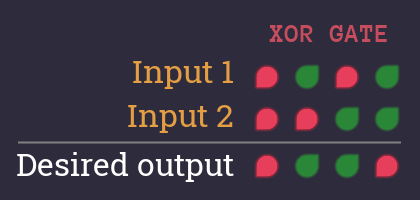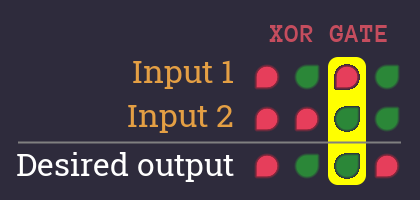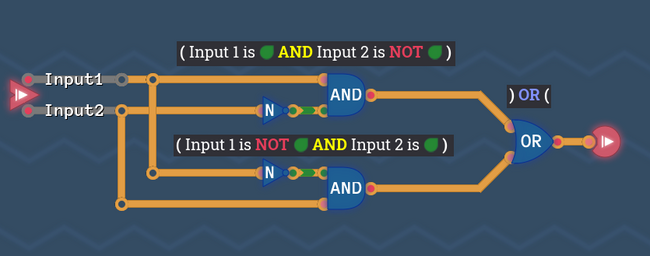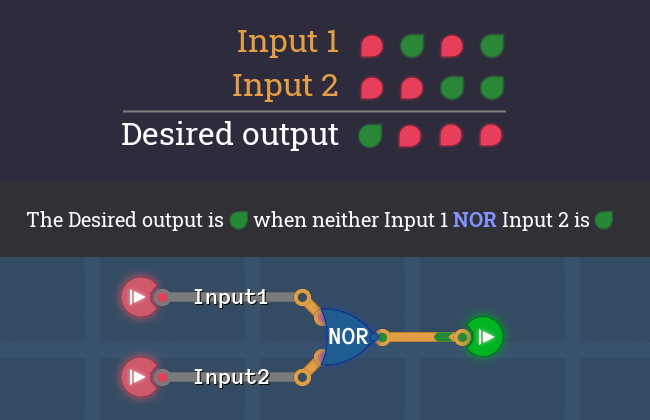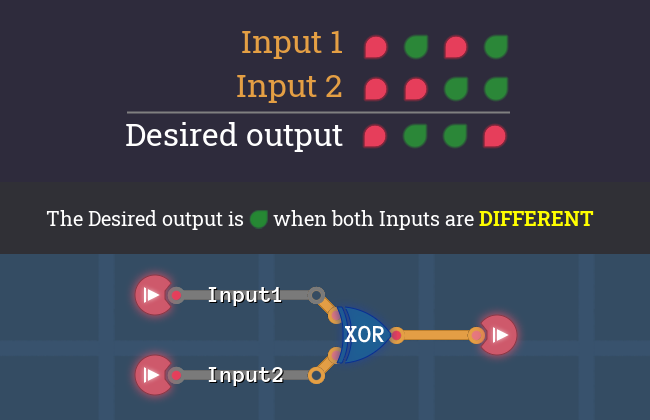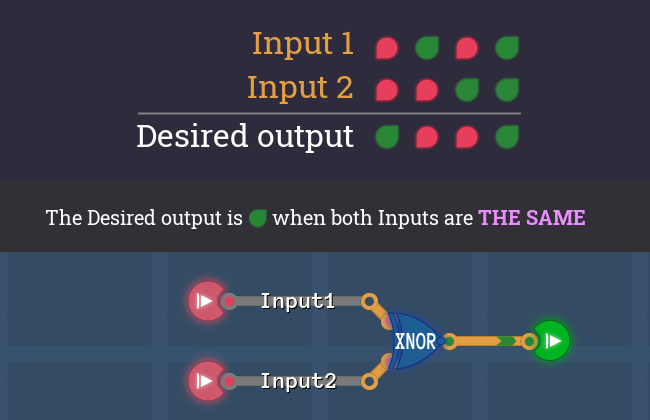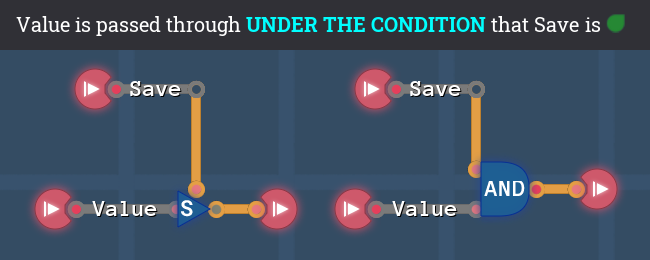m (added some pictures) |
Poppi-Sama (talk | contribs) m (In the Introduction's first paragraph, 2nd sentence, between "the gates" there were 2 spaces instead of just 1, so I got rid of the 2nd space.) |
||
| (5 intermediate revisions by 2 users not shown) | |||
| Line 1: | Line 1: | ||
{{guide|narrow=1}} | |||
=== Introduction === | === Introduction === | ||
This small guide is for players who are completely new to binary logic. It shows how the names of | This small guide is for players who are completely new to binary logic. It shows how the names of the gates correspond to words in a sentence and how they can be used to create circuits by simply describing what you see in a truth table. | ||
This concept might be perceived as obvious for people with background knowledge, but is still something that each of us had to learn at some point. | This concept might be perceived as obvious for people with background knowledge, but is still something that each of us had to learn at some point. | ||
| Line 21: | Line 22: | ||
Let's start with the first and expand our descriptive sentence. | Let's start with the first and expand our descriptive sentence. | ||
[ | [[File:XOR_Gate_TruthTable_Column1.png]] | ||
[[File:Guide_words_description2.png]] | [[File:Guide_words_description2.png]] | ||
| Line 27: | Line 28: | ||
Nice! Okay that's the first column - now let's add the second. | Nice! Okay that's the first column - now let's add the second. | ||
[ | [[File:XOR_Gate_TruthTable_Column2.png]] | ||
[[File:Guide_words_description3.png]] | [[File:Guide_words_description3.png]] | ||
| Line 54: | Line 55: | ||
Now we can build a circuit that exactly matches our description, using the same gates that we highlighted in our sentence: | Now we can build a circuit that exactly matches our description, using the same gates that we highlighted in our sentence: | ||
[ | [[File:XOR_Gate_Circuit1.png|650px]] | ||
This technique works for every truth table. | This technique works for every truth table. | ||
| Line 69: | Line 70: | ||
==== NOR gate ==== | ==== NOR gate ==== | ||
[ | [[File:NOR_Gate_TruthTable_Description_Circuit.png]] | ||
==== XOR gate ==== | ==== XOR gate ==== | ||
| Line 75: | Line 76: | ||
Phrases like ''"...different values"'' or ''"...not the same"'' translate into an '''XOR''' gate | Phrases like ''"...different values"'' or ''"...not the same"'' translate into an '''XOR''' gate | ||
[ | [[File:XOR_Gate_TruthTable_Description_Circuit.png]] | ||
==== XNOR gate ==== | ==== XNOR gate ==== | ||
| Line 81: | Line 82: | ||
Phrases like ''"...equal values"'' or ''"...the same"'' translate into an '''XNOR''' gate | Phrases like ''"...equal values"'' or ''"...the same"'' translate into an '''XNOR''' gate | ||
[ | [[File:XNOR_Gate_TruthTable_Description_Circuit.png]] | ||
==== Conditions ==== | ==== Conditions ==== | ||
| Line 87: | Line 88: | ||
Phrases like ''"...under the condition that..."'' or ''"If...then"'' translate into an '''AND''' gate or a '''SWITCH''' | Phrases like ''"...under the condition that..."'' or ''"If...then"'' translate into an '''AND''' gate or a '''SWITCH''' | ||
[ | [[File:COND_Description_Circuit.png]] | ||
Latest revision as of 00:04, 21 August 2024
Introduction[edit | edit source]
This small guide is for players who are completely new to binary logic. It shows how the names of the gates correspond to words in a sentence and how they can be used to create circuits by simply describing what you see in a truth table.
This concept might be perceived as obvious for people with background knowledge, but is still something that each of us had to learn at some point.
Step 1: Describe the green outputs[edit | edit source]
Let's take a look at the XOR level and its truth table
We want to describe each combination, that turns the desired output ![]()
What's the idea? If we make sure that our circuit outputs ![]() in all relevant cases, then it automatically outputs
in all relevant cases, then it automatically outputs ![]() in all other cases. So we only have to focus on the
in all other cases. So we only have to focus on the ![]() and get the
and get the ![]() s for free.
s for free.
Start like this:
There are 2 columns, that turn the desired output to ![]() .
.
Let's start with the first and expand our descriptive sentence.
Nice! Okay that's the first column - now let's add the second.
Step 2: Replace 'Red' with 'Not Green'[edit | edit source]
We only focus on ![]() signals, that's why we try to avoid using the
signals, that's why we try to avoid using the ![]() symbol in our description.
symbol in our description.
Here is the trick: When something is ![]() , we can also say it is 'not
, we can also say it is 'not ![]() '.
'.
Step 3: Highlight the gate names[edit | edit source]
The connecting words in our sentence are also the name of gates!
Let's highlight all words, that are also names of gates and see what it looks like:
Notice, that i also added some brackets, since AND is a stronger connection than OR.
Step 4: Build the circuit[edit | edit source]
Now we can build a circuit that exactly matches our description, using the same gates that we highlighted in our sentence:
This technique works for every truth table.
The structure of the resulting circuit is called Canonical Disjunctive Normal Form (CDNF) which can usually be optimized to require fewer gates (there are several techniques to achieve this).
More phrases[edit | edit source]
By using phrases that contain only AND, OR, and NOT, you can build any circuit you want, by simply describing each combination for each ![]() output. But there is more...
output. But there is more...
You can use the following phrases and translate them into gates:
NOR gate[edit | edit source]
XOR gate[edit | edit source]
Phrases like "...different values" or "...not the same" translate into an XOR gate
XNOR gate[edit | edit source]
Phrases like "...equal values" or "...the same" translate into an XNOR gate
Conditions[edit | edit source]
Phrases like "...under the condition that..." or "If...then" translate into an AND gate or a SWITCH
